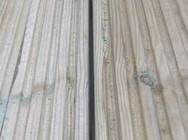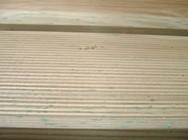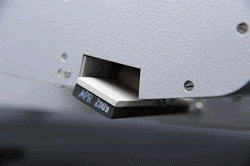This popular choice of exterior pedestrian surface comes in a variety of types and designs and is often found to provide inadequate friction to prevent slip accidents. The nature of the products also present several challenges in obtaining accurate slip testing data.
In the same manner as interior floors, exterior decking should provide a “Low Risk of Slip” as defined by the HSE. Typically, this will mean a minimum of 36 PTV when tested in accordance with BS 7976 with water as the contaminant. As always the contaminant used in the test should be representative of the types likely to be found in end use, or the slip resistance value is somewhat academic.
Directionality
Due to the anisotropic grain structure of wooden decking, its slip resistance is highly likely to depend on the direction in which it is tested, or indeed, the direction in which a person walks upon it.
The slip resistance measured along the grain of the wood is likely to be lower than that measured across the grain. The profile cut along the grain of many types of decking will help increase slip resistance across the grain but will do nothing to help it in the along direction. In fact, the reduction in sole/decking contact area may even reduce slip resistance. For this reason, wherever possible, decking should be laid with the profile or grain running perpendicular to the direction of travel. This is easily achieved on a bridge or walkway, but less so in larger circulation areas.
Due to this sensitivity to direction, care must be taken in testing the surface to ensure the results accurately reflect the real-world slip risk. The Pendulum tester must be carefully aligned and each test must be conducted in at least the three directions (0°, 45° & 90°) stipulated by BS 7976.
The effect of micro-profile on slip resistance
Almost all wooden decking will present a Micro-Profile, often called Surface Roughness, which is provided by the grain of the wood. The extent of this roughness is dependent on how the wood is processed and finished, but unless the wood has been polished – an unlikely scenario for exterior decking – the effect on the slip resistance will be significant.
Any sealants, varnishes, or similar finishes can smooth the micro-roughness and decrease slip resistance. However, such products may introduce a roughness of their own, either naturally, or by the inclusion of an embedded anti-slip particulate. Both may aid slip resistance and also reduce the directional effect.
The effect of macro-profile on slip resistance
Whilst standard decking relies solely on micro-roughness to provide a degree of slip resistance, many types of decking incorporate a macro-profile cut into the surface. The edges of the peaks of such profiles pierce the lubricating film of contaminant and bite into the rubber of either a person’s shoe soles, or the calibrated slider on a Pendulum tester, increasing friction.
The sharper the edges of the profile, the more pronounced this effect. The edges will become gradually rounded over time due to wear and slip resistance is likely to gradually decrease. This is one reason why regular, periodic testing is important to ensure ongoing, documented, compliance.
The peaks of the profile in contact with the shoe sole still offer the benefit of micro-roughness discussed above, although over a reduced area. There is often a trade-off between the beneficial effects of micro and macro profile.

Variability
Wood, as a natural product, is typically subject to greater variability than many man-made materials. This can result in batch-to-batch and even plank-to-plank changes in slip resistance. Therefore, any slip resistance results given by suppliers or manufacturers may differ from the installed product. In-situ testing of flooring is always important and decking is no exception. If variability is evident, more tests per given area of flooring may be required to establish an accurate, representative slip resistance value.
Organic Growth
Organic growth on wooden decking is common and is often detrimental to slip resistance. Such growth forms a semi-solid contaminant when combined with water that the profile of the wood is often unable to deal with. Anti-fungal treatments can help, as will periodic mechanical cleaning. Aggressive anti-slip treatments can also help.
Due to its absorbent nature, wood will remain “wet” for longer than many other surfaces. Only a microscopic film of water is required to facilitate a slip and damp wood is likely to provide this. This is an important consideration for those who might say that decking will only be used in dry conditions. The surface may remain wet for a considerable time after rain has ceased.

The challenges of testing decking
The aggressive macro-profile in particular of many types of decking presents a number of challenges when trying to obtain accurate test data. It is important that the Pendulum operator is aware of these and has the experience to deal with them. Such issues include:
Slider type
The rubber sliders used by a Pendulum tester are available in several different grades. The relative hardness of the different rubbers are used to simulate different types of footwear (or barefoot) and one should be chosen to best represent the type of footwear expected in end use. However, softer rubbers can provide a more accurate test of heavily profiled surfaces, such as decking. Experience will suggest which slider will provide the best compromise. If there is any doubt, multiple tests should be conducted using different sliders.
Angle of impact
When a test is conducted precisely perpendicular to a uni-directional macro profile, the slider will bump over every peak and fall into every valley, striking the edge of the next peak over the full width of the slider. This usually produces a “best case” test result. If the angle that the slider strikes the surface is changed slightly, the slider can remain supported at all times by the profile peaks and fall into none of the valleys. This is likely to produce a markedly different test result.
As the likelihood of a pedestrian walking precisely perpendicular to the profile is somewhat limited, the values obtained by testing in this manner are not to be considered representative of end use. Strictly following BS 7976, manufacturers can mislead end users as to the real performance of their products in end use. The value of a Grip Potential assessment is that we can apply our expert knowledge and experience in providing an unbiased ‘real world’ slip resistance value.
Effective contact area
Again, when testing perpendicular to a uni-directional macro profile, the Pendulum tester can be set to first strike the test surface either on a peak, or in a valley. This often results in a significantly different test result and it is indicative of real-world slip incidents and not a limitation of the test. It is important that the Pendulum operator is aware of this effect and properly accounts for it.
Plastic Decking
Imitation wood decking is an increasingly common choice. Often made from recycled plastic or similar materials it can be a more environmentally friendly option compared to wood. As an engineered product there is the opportunity to design a surface with a good micro-profile and with appropriate quality control the product can be more consistent than wooden products. Man-made materials are also often less susceptible to organic growth than wood.
Increasing Slip Resistance
With many types of decking, both profiled and standard, being slippery along the grain in wet conditions it would be prudent to consider some means of increasing slip resistance. As mentioned above, resin, paint or lacquer products incorporating anti-slip particulate can be effective. For decking with a reasonably well-spaced profile, strips of anti-slip material can be inserted into the valleys. The relative height and spacing of such strips, though, is important to their effectiveness.
Any such remedies should be properly tested independently using the TRL Pendulum test machine to ensure they are appropriate and effective. Wear will reduce the performance of these products and periodic testing should be considered. The type and quantity of traffic will determine the wear rate and appropriate interval for testing.
Conclusion
Timber decking is a popular choice for external circulation areas, including restaurants, pubs, bars and hotels. The surface is highly directional and can be very slippery along the grain/profile. The decked space should be organised taking this into account as much as is possible. The surface should be carefully monitored to ensure it does not become slippery through contamination such as rain, spilled drinks or organic growth. If the surface does pose a significant slip risk then a suitable anti-slip treatment should be undertaken by a slip test service, tested and documented by independent experts.












